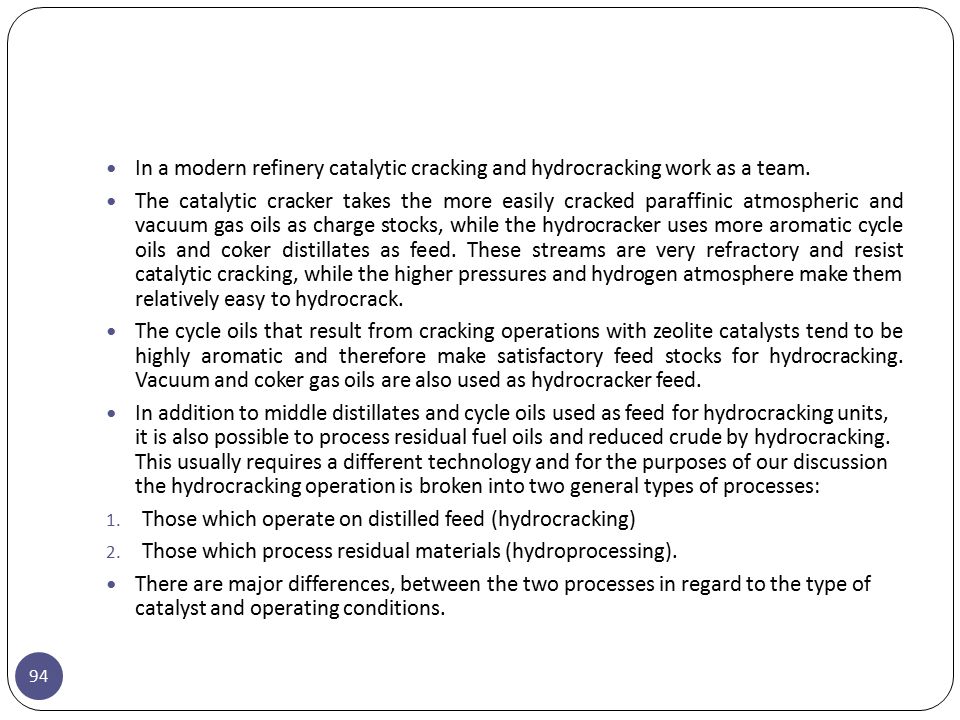Advantages Of Hydrocracking Reaction

The main advantages of hydrocracking process are: its flexibility with respect to production of gasoline and middle distillates, quality of its products; ability to handle a wider range of feedstock like cycle oils from other cracking units. The reaction of desulphurisation, denitrogenation and de-oxygenation.
Author: Vincenzo Piemonte, Associate Professor, University UCBM – Rome (Italy) 1.Theme description Worldwide economic growth continues to drive demand for transportation fuels, and in part There are several processes presently able to meet individual refinery needs and project objectives. In particular, UOP LLC Company is one of the most active society in this field. The basic flow schemes considered by UOP are single-stage or two-stage design.
UOP two-stage Unicracking process flow schemes can be a separate hydrotreat or a two-stage process as shown in Figure 1. Calculo larson pdf 9 edicion. In the separate hydrotreat flow scheme the first stage provides only hydrotreating while in the two-stage process the first stage provides hydrotreating and partial conversion of the feed. The second-stage provides the remaining conversion of recycled oil so that overall high conversion from the unit is achieved.

These flow schemes offer several advantages in processing heavier and highly contaminated feeds. Two-stage flow schemes are economical when the throughput of the unit is relatively high. The design of hydrocracking catalyst changes depending upon the type of flow scheme employed. The hydrocracking catalyst needs to function within the reaction environment and severity created by the flow scheme that is chosen.
2.Enhanced Hydrocracking Processes During the early years of hydrocracking, refiners were mainly interested in maximizing production of naphtha for reforming to high octane gasoline. However with advancements in hydrocracking catalyst technology, and the demand for maximizing distillate yields from heavier feedstocks, two-stage design offers a cost-effective option for a larger capacity maximum distillate unit operation. A major difference between the first and second stage hydrocracking reactor reaction environments lies in the very low concentrations of ammonia and hydrogen sulfide in the second-stage (see figure 2).
The first-stage reaction environment is rich in both ammonia and hydrogen sulfide generated by hydrodenitrogenation and hydrodesulfurization of the feed. This significantly impacts reaction rates, particularly cracking reaction rates, leading to different product selectivity and catalyst activity between the two-stages. The catalyst system can be optimized to obtain a highly distillate selective overall yield structure.
Optimum severity can be set for each stage to achieve catalyst life target with minimum catalyst volume. Overall, the two-stage design allows optimization of conversion severity between the two stages, maximizing overall distillate selectivity. New advances in the two-stage Unicracking process design include several innovations in each reaction section of the design. The pretreating section uses a high activity pretreating catalyst that allows hydrotreating at a higher severity, providing good quality feed for the first-stage hydrocracking section and enabling maximum first-stage selectivity to high quality distillate. The second-stage is optimized by use of second-stage hydrocracking catalyst that is specifically designed to take advantage of the cleaner reaction environment. The second-stage catalyst is designed so that the cracking and metal functions are balanced. At the same time the second-stage hydrocracking severity is optimized so that maximum distillate selectivity is obtained from the second-stage of hydrocracking.
Figure 1 – Two-stage Unicracking Process Flow Schemes. Figure 2 – Two-stage Unicracking Process Flow Schemes. 3.Catalyst Development Designing catalysts which can be successfully used for processing heavy feeds requires an understanding of the interactions of many factors. Detailed knowledge is increasingly important for controlling reaction pathways to achieve specific product types to meet today’s market demands. The key considerations for optimal catalyst design require good understanding of the molecular transformations of feed to product with respect to catalyst functions and process variables. Such consideration involves process severity and its impact on the extent of secondary cracking in the hydrocracking reactor. The key steps in the mechanism of hydrocracking paraffins consists of a sequence of steps beginning with dehydrogenation at metal sites to form olefinic intermediates which are then protonated at the acid sites to form the reactive carbenium ions.
These, in turn, can isomerize and leave the catalyst surface without cracking after picking up a hydride ion at the metal sites. Alternatively, they can crack to form smaller alkanes which then leave the catalyst surface as hydrocracked products.